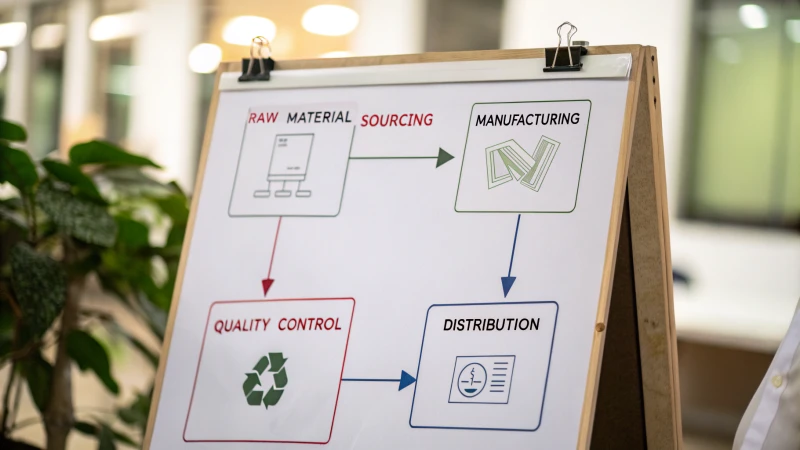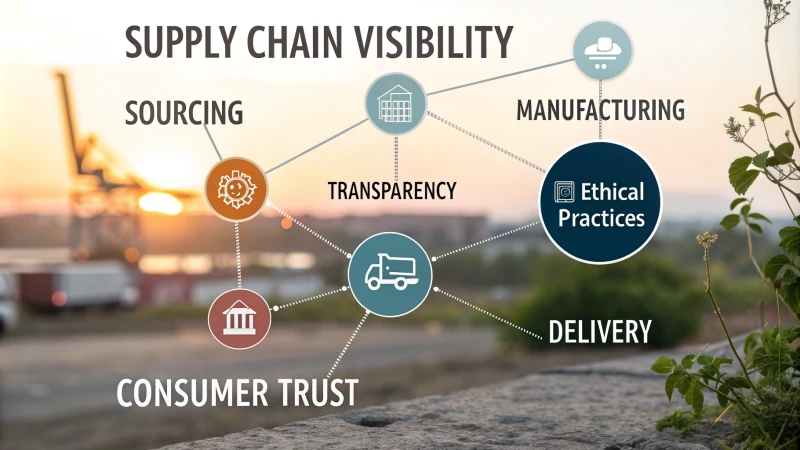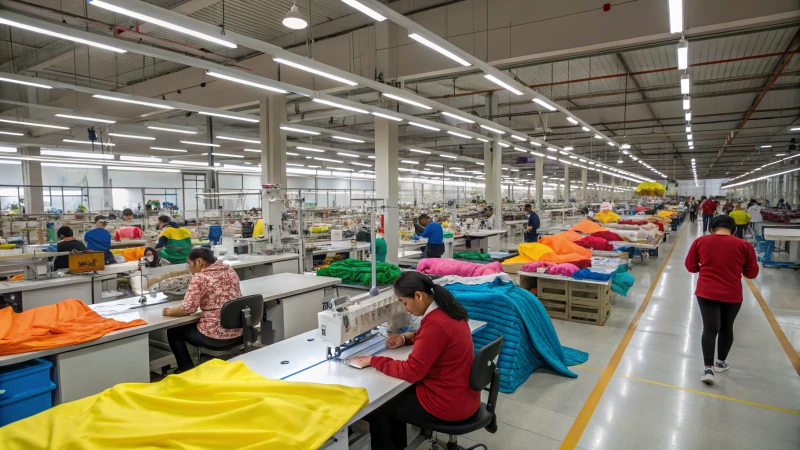
Have you ever thought about the origin of your favorite underwear?
Transparent supply chains in the underwear industry are like having an open book. Everyone sees each step clearly. Consumers know exactly what happens. Cotton grows in fields and later you receive the product at your doorstep. This clarity builds trust. Companies meet regulations with transparency. It gives brands a real advantage. Brands show they care about ethical practices. This is very important.
I remember when I first understood the journey my clothes take before they reach my closet. It was a very eye-opening moment. I realized how much effort goes into a single pair of underwear. Brands share their processes openly. It feels like they invite us into their world. They tell stories about where they get their materials and how they create their products. This transparency goes beyond meeting rules. It builds real relationships with us, the consumers.
Some brands really lead in transparency. They use tools like blockchain to track each step. They show certifications to prove their claims. They keep communication open and honest. These actions reduce risks. They build stronger connections with their audience. If you are shopping for underwear, consider brands that value transparency. They might become your next favorite.
Transparent supply chains boost consumer trust in underwear brands.True
Transparency allows consumers to verify ethical practices, enhancing trust.
Underwear brands with opaque supply chains face fewer regulatory issues.False
Opaque supply chains are more likely to violate regulations due to lack of oversight.
Why is supply chain transparency crucial for underwear brands?
Have you ever thought about how underwear brands earn our trust? They rely on clear supply chains. This transparency is very important. Trust really grows when we see where products come from.
Supply chain transparency helps underwear brands build consumer trust, increase sustainability and follow regulations. Brands show ethical sourcing and production. They probably stand out in a crowded market through this effort.

Building Consumer Trust
I want to tell you about a time when I changed my underwear brand. I was searching for a brand that fit my beliefs. Then, I found one that shared where their materials came from1 and how they treated workers. This information gave me confidence. Knowing the origin really helps. It turns a hesitant shopper into a faithful supporter.
Improving Brand Reputation
In fashion, a good name is everything. I noticed brands grow fast when they show their processes clearly. They share their journey, from getting materials to making products. This openness grabs attention and earns respect.
| Aspect | Benefit |
|---|---|
| Consumer Trust | Builds loyalty and confidence |
| Brand Reputation | Differentiates in a crowded market |
In the busy underwear market, transparency changes the game entirely.
Sustainability and Ethical Practices
It's pleasing to know our clothes are stylish and sustainable. I was impressed by a brand that used eco-friendly materials2 and treated workers fairly. They talked about it openly. This goes beyond following trends; it leads change and serves eco-friendly buyers.
Following Regulations
Dealing with rules feels like a puzzle. A clear supply chain helps a lot. Using technology like blockchain helps brands follow laws while showing their fairness.
Using Technology for Clarity
About blockchain, it's not just for tech fans. Imagine tracking your product's entire path with a digital tool. This transparency reassures customers interested in the organic cotton3 in our underwear.
Connecting with Consumers Through Stories
Stories hold power. They help us connect deeply. Brands sharing their sourcing tales let us join their journey. This increased loyalty turns customers into promoters who eagerly talk about their beloved brands that share their truth.
Transparency boosts consumer trust in underwear brands.True
Consumers prefer brands that disclose material origins and production conditions.
Supply chain transparency decreases brand reputation.False
Transparency enhances brand reputation by showcasing ethical practices.
How Does Blockchain Technology Enhance Supply Chain Transparency?
Imagine a world where people trace their product's journey from start to finish with just a few clicks. Blockchain technology turns this dream into reality for supply chains everywhere. It really does.
Blockchain improves supply chain transparency. It allows secure and real-time tracking of goods. Tracking starts from their origin and ends with the consumer. Blockchain uses decentralized ledgers to protect data integrity. This reduces fraud and increases trust among stakeholders. People really trust this system.

The Role of Blockchain in Supply Chain Management
Here's a small story. I talked with a friend who owns a little organic coffee shop. She felt stressed about checking if her coffee beans were ethically sourced. She wanted each part of the supply chain to be honest and clear. When blockchain entered her life, everything changed. Every deal, from farmers to distributors, appeared on a decentralized ledger. She viewed data in real-time and confirmed product origins easily. Blockchain simplified her life, making her business very reliable.
Benefits of Better Transparency
- Fraud Reduction: Sleep soundly knowing each transaction in your supply chain stays safe and untouched. That's blockchain's promise; it really changes the game. This is especially important in fields where fake goods are common, like luxury items.
- Improved Accountability: Trust holds everything in business, right? Blockchain lets every supply chain participant check each other's actions. It's like having a guardian angel ensuring everything functions perfectly.
| Benefit | Description |
|---|---|
| Fraud Reduction | Minimizes data tampering and counterfeiting through immutable records. |
| Accountability | Ensures all participants can verify each other's actions and transactions. |
Case Studies: Successful Implementations
Several companies have leveraged blockchain for greater transparency:
- Walmart uses blockchain to trace produce origins, cutting down the time to track contaminated goods during recalls.
- IBM's Food Trust4 connects multiple suppliers to improve food safety.
These stories show that blockchain adoption probably leads to more efficient and safer supply chains.
Challenges in Adoption
It's not all easy; blockchain setup brings challenges such as:
- Scalability Issues: Think about fitting many transactions into a system that sometimes slows and costs more.
- Integration with Existing Systems: There's also the challenge of merging blockchain with current systems—it feels like fitting a new puzzle piece into a very complex picture.
These hurdles need careful planning and step-by-step setup to succeed in blockchain adoption. Once you navigate these challenges, the rewards are really worth it.
Blockchain prevents data tampering in supply chains.True
Blockchain's immutable ledger records every transaction, reducing tampering.
Blockchain increases scalability in supply chain systems.False
Blockchain faces scalability issues as transaction volumes increase.
Why Is Consumer Trust Linked to Supply Chain Visibility?
Have you ever thought about why some brands easily earn our trust? It often involves more than just the product. The path it takes to reach us truly matters. This journey plays a very important role.
Consumer trust connects closely to supply chain visibility. This connection really encourages transparency, honesty and ethical practices. Brands showing their supply chain steps clearly probably gain more consumer confidence. These brands also earn loyalty.

The Role of Transparency
I remember the first time I thought about where my clothes came from. I was shopping for a gift and found a brand that explained where their t-shirts came from - from the cotton fields to the checkout counter. That clear information really connected with me. It wasn’t just buying a shirt; it was buying into a story of ethical sourcing and sustainable methods.
In today's world, transparency in the supply chain is crucial. Consumers like us need to see how products are created, from raw materials to finished goods. This visibility5 reassures us. We know that the brands we support are committed to ethical standards.
| Element | Impact on Trust |
|---|---|
| Sourcing | Ethical sourcing enhances brand credibility. |
| Manufacturing | Transparent processes ensure quality control. |
| Delivery | Timely updates improve reliability. |
Ethical and Sustainable Practices
Modern consumers, like me, are becoming more eco-conscious. We value brands that respect sustainability because it matches our desire to choose environmentally friendly options. Companies that work hard in sustainable sourcing6 or reducing their carbon footprint appeal to our need for responsible consumption. I once read that a huge 88% of consumers want brands to help them make a difference for the environment. That's really a lot of people who prefer brands that share their values.
Technology in Supply Chain Visibility
The rapid progress in technology has also transformed supply chain transparency. Innovations like blockchain and IoT have changed how we track products in real time. These technologies offer proof of authenticity7 and integrity at every stage. For instance, blockchain offers a secure and tamper-proof record of transactions, which gives me peace of mind.
Case Studies: Leading Brands
Think about some leading brands that have embraced supply chain visibility. One notable fashion brand has added QR codes on its clothes. These codes help us, the customers, trace each item’s journey from fiber to fabric. These actions not only build trust but also help brands stand out in a very competitive market.
Consumer Behavior Insights
Knowing what drives consumer behavior is important for using supply chain visibility well. Research shows that many consumers are willing to pay more for products from transparent and responsible brands. This means visible supply chains could lead to higher sales and strong customer loyalty.
Challenges and Opportunities
Implementing a transparent supply chain has challenges - costs can be high and processes complex. Yet, I firmly believe that the opportunities are far greater than these obstacles. Embracing transparency can create deeper connections with us, the customers, leading to increased interaction and better market positioning—maybe it’s a win-win scenario.
Transparency in supply chains boosts consumer trust.True
Transparency reassures consumers about ethical and sustainable practices.
Blockchain technology cannot enhance supply chain visibility.False
Blockchain provides a tamper-proof record, enhancing transparency and trust.
How Can Brands Implement Effective Transparency Practices in Their Supply Chains?
Imagine stepping into a store and knowing exactly where each product originates. Transparency in supply chains offers this power.
Brands use technology like blockchain for effective transparency. They conduct regular audits. They also maintain open communication with stakeholders. These methods create accountability. Consumer trust grows. Strong relationships form. Repeating꞉ Strong relationships truly develop.

Using Technology for Clarity
I remember the first time I heard about blockchain8 in a meeting. It felt like looking into the future. This technology tracks every step in a product's journey. Blockchain provides real-time tracking, ensuring every transaction is secure and immutable. Consumers get detailed insights about their products' origins, boosting trust and credibility. This tool goes beyond security; it builds trust and shows we care about every step.
Performing Regular Audits
Audits might seem intimidating, but they are essential for clarity. I recall a project where regular audits9 revealed a small flaw in our supplier's process. Catching that early prevented a much larger issue. Diligence is necessary; every supply chain part—from raw materials to delivery—must meet our standards.
| Audit Type | Purpose | Frequency |
|---|---|---|
| Supplier Audits | Assess supplier practices | Bi-annually |
| Environmental Audits | Evaluate environmental impact | Annually |
| Quality Audits | Ensure product quality standards | Quarterly |
Encouraging Open Communication
Open communication transformed our work. Sharing updates with stakeholders builds stronger bonds and trust. I once worked on a project where consistent updates smoothed over potential conflicts, keeping everyone informed. Transparency not only strengthens relationships but also instills confidence in our brand.
Example: A Real-World Application
I have witnessed how successful brands apply these strategies. Leading companies partner with third-party organizations to certify their processes, doing more than ticking boxes—they set industry benchmarks and establish dedicated teams to oversee these actions. This shows commitment and significantly increases brand reputation and loyalty.
By integrating these effective transparency practices, brands can enhance their reputation while contributing positively to the industry's movement towards sustainability and ethical business practices.
Blockchain ensures real-time product tracking.True
Blockchain allows for secure, immutable tracking from source to sale.
Conducting audits annually is sufficient for transparency.False
Regular audits, including bi-annual and quarterly, are essential.
Conclusion
Transparent supply chains in the underwear industry enhance consumer trust, promote ethical practices, and leverage technology like blockchain for improved accountability and sustainability.
Discover how knowing the material origin enhances consumer trust by providing transparency about sourcing. ↩
Learn about the impact of eco-friendly materials on sustainability practices in fashion. ↩
Understand how verifying organic cotton sources strengthens trust in sustainable brand claims. ↩
Discover how IBM's Food Trust blockchain enhances food safety and traceability for multiple suppliers. ↩
Explores the connection between transparent supply chains and consumer trust, offering detailed insights into the benefits of visibility. ↩
Highlights real-world examples of sustainable practices in supply chains, showcasing how brands achieve transparency. ↩
Delves into how blockchain technology ensures authenticity and transparency in supply chains. ↩
Learn how blockchain technology enhances transparency by providing real-time tracking and secure transactions. ↩
Discover why regular audits are critical in maintaining supply chain integrity and compliance. ↩






